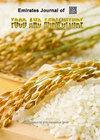夜温胁迫对面包小麦(Triticum aestivum L.)的生理生化影响
IF 0.7
4区 农林科学
Q3 AGRONOMY
引用次数: 0
摘要
巴纳拉斯印度教大学农业科学研究所植物生理学系进行了一项实验室实验,以评估夜间温度升高对小麦(Triticum aestivum L.)的影响,观察两个小麦栽培品种,即 HUW-234(相对耐受热胁迫)和 sonalika(相对易受热胁迫)的一些抗氧化和生化参数的反应。在与抗氧化系统有关的参数中,发现在胁迫条件下(昼夜温差为 250 摄氏度/240 摄氏度)的植株比在控制条件下(昼夜温差为 250 摄氏度/150 摄氏度)的植株的过氧化氢酶、SOD 和 APX 活性显著增加。抗逆基因型(HUW-234)的抗氧化酶活性增加百分比高于易感基因型(Sonalika)。据报告,在胁迫条件下,耐受基因型的过氧化氢酶活性比对照基因型提高了 23.52%。叶绿素'a'、叶绿素'b'和膜热稳定性指数等大多数光合作用和膜参数都显著降低。在夜间高温条件下,易感品种的生化参数(总蛋白含量、淀粉含量和可溶性糖含量)也出现了类似的百分比下降。根据两年实验的综合数据,可以得出结论:品种 HUW-234 比品种 sonalika 更能承受 HNT 胁迫。 关键字高夜温 小麦 过氧化氢酶活性 抗氧化系统本文章由计算机程序翻译,如有差异,请以英文原文为准。
Physiological and Biochemical Effect of Elevated Night Temperature Stress on Bread Wheat (Triticum aestivum L.)
A laboratory experimentation was done in the Department of Plant Physiology, Institute of Agricultural Sciences, Banaras Hindu University to evaluate elevated night temperature effect in wheat (Triticum aestivum L.) to see the response in some antioxidant and biochemical parameters in two wheat cultivars viz. HUW-234 (comparatively tolerant to heat stress) and sonalika (comparatively susceptible to heat stress). A significance difference was recorded in the parameters pertaining to antioxidant system includes catalase, SOD and APX activity were found to increase substantially when the plants kept under stress conditions (250C/ 240C day and night temperature) than the plants kept under controlled condition (250C/150C day and night temperature). The percent increase in the antioxidant enzyme activity was found to be more in the tolerant genotype (HUW-234) than in the susceptible genotype (Sonalika). There was 23.52 % increase was reported in the catalase activity by tolerant genotype when kept under stress conditions than those kept under control. Significant reductions were reported in most of the photosynthetic and membrane parameters viz., chlorophyll ‘a’, chlorophyll ‘b’ and membrane thermostability index. Similar percent reduction was reported with respect to biochemical parameters (total protein content, starch content and soluble sugar content) in the susceptible variety kept under high night temperature regime. Based on the pooled data of two-year experimentation it can be concluded that variety HUW-234 was found to be more tolerant than variety sonalika to HNT stress. Key Words: High night temperature, Wheat, Catalase activity, Anti-oxidant system.
求助全文
通过发布文献求助,成功后即可免费获取论文全文。
去求助
来源期刊

Emirates Journal of Food and Agriculture
AGRONOMYFOOD SCIENCE & TECHNOLOGY&nb-FOOD SCIENCE & TECHNOLOGY
CiteScore
1.80
自引率
0.00%
发文量
18
期刊介绍:
The "Emirates Journal of Food and Agriculture [EJFA]" is a unique, peer-reviewed Journal of Food and Agriculture publishing basic and applied research articles in the field of agricultural and food sciences by the College of Food and Agriculture, United Arab Emirates University, United Arab Emirates.
 求助内容:
求助内容: 应助结果提醒方式:
应助结果提醒方式:


